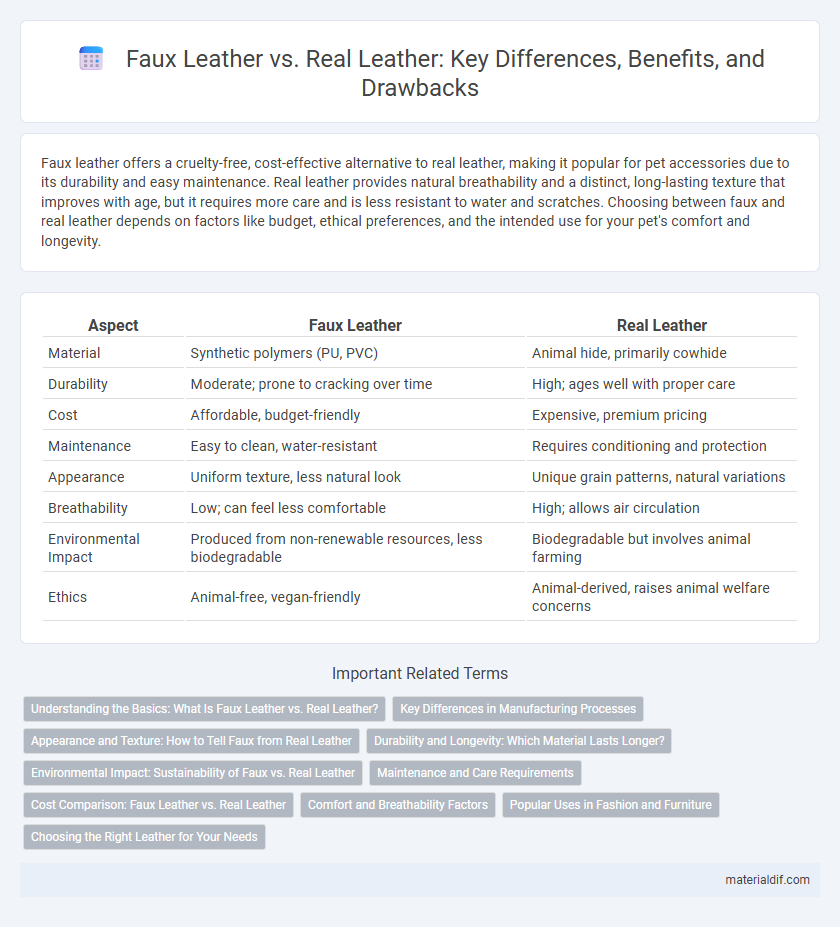Faux leather offers a cruelty-free, cost-effective alternative to real leather, making it popular for pet accessories due to its durability and easy maintenance. Real leather provides natural breathability and a distinct, long-lasting texture that improves with age, but it requires more care and is less resistant to water and scratches. Choosing between faux and real leather depends on factors like budget, ethical preferences, and the intended use for your pet's comfort and longevity.
Table of Comparison
| Aspect | Faux Leather | Real Leather |
|---|---|---|
| Material | Synthetic polymers (PU, PVC) | Animal hide, primarily cowhide |
| Durability | Moderate; prone to cracking over time | High; ages well with proper care |
| Cost | Affordable, budget-friendly | Expensive, premium pricing |
| Maintenance | Easy to clean, water-resistant | Requires conditioning and protection |
| Appearance | Uniform texture, less natural look | Unique grain patterns, natural variations |
| Breathability | Low; can feel less comfortable | High; allows air circulation |
| Environmental Impact | Produced from non-renewable resources, less biodegradable | Biodegradable but involves animal farming |
| Ethics | Animal-free, vegan-friendly | Animal-derived, raises animal welfare concerns |
Understanding the Basics: What Is Faux Leather vs. Real Leather?
Faux leather is a synthetic material designed to replicate the look and feel of real leather but is made from plastic-based substances like polyurethane or polyvinyl chloride, making it more affordable and animal-friendly. Real leather is derived from animal hides through a tanning process, offering durability, breathability, and a unique aging patina that faux leather cannot mimic. Understanding the fundamental differences in origin, texture, and maintenance helps in making informed choices between faux leather's ethical appeal and real leather's natural authenticity.
Key Differences in Manufacturing Processes
Faux leather is produced by applying layers of plastic, typically polyurethane or polyvinyl chloride, over a fabric backing through processes such as coating or embossing, resulting in a synthetic material. Real leather undergoes tanning, a chemical treatment of animal hides, either through vegetable or chrome tanning, which preserves and strengthens the natural fibers. The manufacturing of real leather emphasizes durability and unique texture developed over time, while faux leather prioritizes uniformity and cost-effectiveness.
Appearance and Texture: How to Tell Faux from Real Leather
Real leather exhibits natural grain patterns and unique imperfections, giving it a distinct, rich texture that feels supple and warm to the touch. Faux leather often has a uniform surface with an artificial sheen and may feel more rigid or plasticky compared to genuine leather. Close inspection reveals real leather's pores and slight wrinkles, while faux leather tends to have a consistent, synthetic texture without natural variations.
Durability and Longevity: Which Material Lasts Longer?
Faux leather offers a budget-friendly alternative but typically shows signs of wear, such as cracking and peeling, within a few years due to its synthetic composition. Real leather, derived from animal hides, ages gracefully by developing a patina and can last several decades when properly maintained, showcasing superior durability. The natural fibers in real leather provide enhanced resistance to tearing and stretching, making it the longer-lasting option in most use cases.
Environmental Impact: Sustainability of Faux vs. Real Leather
Faux leather, made primarily from polyurethane or polyvinyl chloride, poses environmental challenges due to its reliance on fossil fuels and non-biodegradable properties, contributing to microplastic pollution and landfill waste. Real leather, derived from animal hides, involves significant water consumption, deforestation for livestock grazing, and methane emissions, impacting greenhouse gas levels and biodiversity. Sustainable alternatives focus on innovations like vegetable-tanned leather and bio-based faux leathers, which aim to reduce environmental footprints while balancing durability and ethical concerns.
Maintenance and Care Requirements
Faux leather requires less maintenance than real leather, as it is resistant to stains, water, and cracking, needing only occasional wiping with a damp cloth to stay clean. Real leather demands regular conditioning with leather-specific products to prevent drying and cracking, along with careful protection from moisture and direct sunlight to maintain its durability and appearance. Both materials benefit from immediate cleaning of spills, but faux leather offers greater convenience and lower upkeep costs for long-term care.
Cost Comparison: Faux Leather vs. Real Leather
Faux leather offers a significantly lower price point compared to real leather, making it a cost-effective alternative for budget-conscious consumers. Real leather involves higher production costs due to the tanning process and quality of animal hides, driving its market price upwards. While faux leather reduces upfront expenses, the durability and longevity of real leather often justify its higher investment over time.
Comfort and Breathability Factors
Faux leather tends to be less breathable than real leather, which can cause discomfort and increased sweating during prolonged use due to its synthetic composition. Real leather naturally allows air circulation and absorbs moisture, enhancing comfort by maintaining a balanced temperature against the skin. The porous texture of genuine leather provides superior breathability, making it a preferred choice for upholstery and clothing where comfort is a priority.
Popular Uses in Fashion and Furniture
Faux leather is widely favored in fashion for its affordability, cruelty-free appeal, and versatility in producing trendy jackets, bags, and shoes. In furniture, real leather remains popular due to its durability, breathability, and ability to develop a unique patina over time, making it ideal for luxury sofas and chairs. Both materials serve distinct demands, with faux leather often chosen for cost-effective, lightweight applications, while real leather is preferred for high-end, long-lasting furniture pieces.
Choosing the Right Leather for Your Needs
Faux leather offers a cruelty-free and cost-effective alternative to real leather, making it ideal for budget-conscious consumers seeking stylish, low-maintenance options. Real leather provides superior durability, breathability, and natural aging, better suited for high-quality furniture, luxury accessories, and long-term use. Consider factors like sustainability, usage frequency, and desired aesthetics when choosing between faux leather and real leather to ensure the best fit for your lifestyle and values.
Faux Leather vs Real Leather Infographic

 materialdif.com
materialdif.com